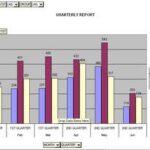When it comes to chart analysis, unusually large and small ranges have a lot of meaning. Measuring the distance between opening and closing price tells you a lot when trends develop or begin to lose momentum. Some specific patterns are excellent gauges of when reversal in the trend is likely to occur.
First a few terms: The “real body” is the range between opening and closing price, shown as a rectangle in the candlestick, which is either white (prices moved up) or black (prices moved down). The “upper and lower shadows” are seen as stocks on both sides of the real body, and the span of the shadows represents the session’s trading range.
An exceptionally large range between opening and closing price is seen in extended real bodies of candles. A long candlestick showing up at the end of a trend and going in the opposite direction often signals a sudden reversal. For example, after a series of black candlesticks, a long white candle may begin an uptrend. (The same applies with a long black candle after a series of white sessions.)
Even more convincing, though, is a variation of the long candlestick canned a “marubozu.” In Japanese, this means “with little hair.” It is so called because it consists of an exceptionally long real body and little or no shadows (the sticks above or below the real body representing the total trading range). The marubozu is an especially convincing reversal signal due to having little or no trading outside of the space between opening and closing price.
On the opposite end of the extreme spectrum is the very narrow real body. When trading opens and closes at or very near to the same price, the resulting real body shows up as only a horizontal line. This called a “doji,” which means “mistake” in Japanese. When you see one of these at the end of a trend, it has a strong reversal indication. This is especially true when seen at the top of an uptrend and with a long upper shadow. This tells you that price did not move much, even though buyers tried to push it higher and failed. At the bottom of a downtrend, a doji with a long lower shadow tells you the same thing: Sellers tried to push price lower but did not succeed. In either case, it presents a strong possibility of a fast turnaround.
These examples are limited to single-session candlesticks. You gain much more insight when you also study two-session and three-session patterns. As measurements of momentum and trading trend reversals, candlesticks are great initial indicators and also serve well to confirm what you find in traditional patterns (head and shoulders, breakouts, gaps, etc.). Candlesticks are even more visual than the well-known price patterns most chartists know well.
Price tends to move in short-term cycles, and these candlestick formations are very revealing. They are not only shapes, but visual reflections of increasing or decreasing momentum. Once you understand how to interpret the candlestick, your timing for both entry and exit will improve considerably.
To gain more perspective on insights to trading observations and specific strategies, I hope you will join me at ThomsettOptions.com where I publish many additional articles. I also enter a regular series of daily trades and updates. For new trades, I usually include a stock chart marked up with reversal and confirmation, and provide detailed explanations of my rationale. Link to the site at ThomsettOptions.com to learn more.
I also offer a weekly newsletter subscription if you are interested in a periodic update of news and information and a summary of performance in the virtual portfolio that I manage. All it requires is your e-mail address. Join at Weekly Newsletter I look forward to having you as a subscriber.





